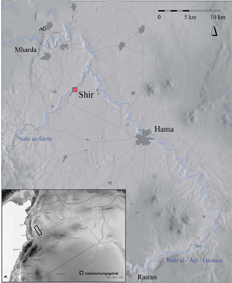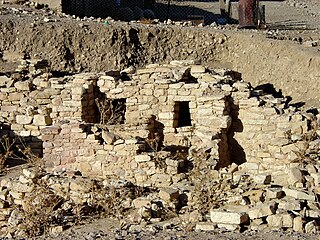
Nevalı Çori was an early Neolithic settlement on the middle Euphrates, in Şanlıurfa Province, Southeastern Anatolia, Turkey. The site is known for having some of the world's oldest known temples and monumental sculpture. Together with the earlier site of Göbekli Tepe, it has revolutionised scientific understanding of the Eurasian Neolithic period. The oldest domesticated Einkorn wheat was found there.

The Butmir culture was a major Neolithic culture in central Bosnia, developed along the shores of the river Bosna, spanning from Sarajevo to Zavidovići. It was discovered in 1893, at the site located in Butmir, in the vicinity of Ilidža, which gave its name to an entire cultural group of the Late Neolithic in central Bosnia, the Butmir culture. It is characterized by its unique elaborately decorated pottery and anthropomorphic Figurines, and is one of the best researched European cultures from 5100 to 4500 BC. It was part of the larger Danube civilization. The largest Butmir site is in Visoko basin, in Okolište.

The Gottfried Wilhelm Leibniz Prize, or Leibniz Prize, is awarded by the German Research Foundation to "exceptional scientists and academics for their outstanding achievements in the field of research". Since 1986, up to ten prizes have been awarded annually to individuals or research groups working at a research institution in Germany or at a German research institution abroad. It is considered the most important research award in Germany.

Ma'an is one of the governorates of Jordan, it is located south of Amman, Jordan's capital. Its capital is the city of Ma'an. This governorate is the largest in the kingdom of Jordan by area.

The Münstertal is a municipality in the southern Black Forest, which belongs to the district of Breisgau-Hochschwarzwald in Baden-Württemberg in southern Germany. It is 3 miles east from Staufen.

Ghassulian refers to a culture and an archaeological stage dating to the Middle and Late Chalcolithic Period in the Southern Levant. Its type-site, Teleilat Ghassul, is located in the eastern Jordan Valley near the northern edge of the Dead Sea, in modern Jordan. It was excavated in 1929-1938 and in 1959–1960, by the Jesuits. Basil Hennessy dug at the site in 1967 and in 1975–1977, and Stephen Bourke in 1994–1999.

Kamid el-Loz, also spelled Kamid al-Lawz, is located in West Bekaa, Lebanon. The settlement has a population numbering several thousand, mostly Sunni, people and is also a site of archaeological excavations.

Aşıklı Höyük is a settlement mound located nearly 1 kilometre (0.62 mi) south of Kızılkaya village on the bank of the Melendiz brook, and 25 km (16 mi) southeast of Aksaray, Turkey. Aşıklı Höyük is located in an area covered by the volcanic tuff of central Cappadocia, in Aksaray Province. The archaeological site of Aşıklı Höyük was first settled in the Pre-Pottery Neolithic period, around 8,200 BC.
Dieter Vieweger, a Biblical scholar and Prehistoric Archaeologist, was born in Chemnitz, East Germany in 1958. He studied Theology and Prehistoric Archaeology in Leipzig and Frankfurt am Main. After that he held a number of distinguished research and educational positions. Today he teaches at the „Kirchliche Hochschule Wuppertal“, and the universities of Münster and Witten-Herdecke while also being the director of scientific institutes in Jerusalem and Amman as well as in Wuppertal.
Tel Ali is an archaeological site located one mile south of the Sea of Galilee, in the central Jordan Valley, Israel. It has been excavated twice. First, during the years 1955–1959, Moshe Prausnitz conducted salvage excavations on behalf of the Israel Department of Antiquities. He published only preliminary reports and most of the excavation finds remained unstudied. Prausnitz uncovered a detailed sequence of occupation including: Pre-Pottery Neolithic B, Pre-Pottery Neolithic C, Pottery Neolithic B, Middle Chalcolithic and Late Chalcolithic (Ghassulian). However, at the time of excavation many of these phases had not yet been defined.
Neue Marx-Lektüre or NML is a revival and interpretation of Karl Marx's critique of political economy, which originated during the mid-1960s in both Western and Eastern Europe and opposed both Marxist–Leninist and social democratic interpretations of Marx. Neue Marx-Lektüre covers a loose group of authors primarily from German-speaking countries who reject certain historicizing and empiricist interpretations of Marx's analysis of economic forms, many of which are argued to spring from Friedrich Engels role in the early Marxist workers' movement.
Adrian Nigel Goring-Morris is a British-born archaeologist and a professor at the Hebrew University of Jerusalem in Israel.
Avi Gopher is an Israeli archaeologist. He is a professor at the University of Tel Aviv.

Beidha, also sometimes Bayda, is a major Neolithic archaeological site a few kilometres north of Petra near Siq al-Barid in Jordan. It is included in Petra's inscription as a UNESCO World Heritage Site.

Shir is a Late Neolithic site in western Syria, located 12 km northwest of Hama, capital of the province by the same name. The settlement of Shir is situated upon a 30-m high terrace formation above the Nahr as-Sārūt, a tributary of the Orontes River.
Klaus Oeggl is a retired Austrian botanist, and deals with palaeoecology and archaeobotany. He is well known for his studies on the life-circumstances and on the environment of the Neolithic glacier mummy "Ötzi".

Paul Grimm was a German prehistorian and also a pioneer of Medieval archaeology, especially of the excavation of abandoned villages and castles. Grimm worked on various periods, but mainly in central Germany – the names of two important Neolithic archaeological cultures in the area, the Baalberge group and the Salzmünde group derive from him. His comprehensive excavations at Hohenrode and Tilleda were important milestones in the history of German archaeology.

Basta is a pre-historic archaeological site and village in Ma'an Governorate, Jordan, 36 kilometres (22 mi) southeast of Petra. It is named for the nearby contemporary village of Basta. Like the nearby site of Ba'ja, Basta was built in c. 7000 BC and belongs to the PPNB period. Basta is one of the earliest known places to have a settled population who grew crops and domesticated livestock.
Zeidan A. Kafafi is a Jordanian archaeologist and academic who has directed and otherwise contributed to numerous excavations in and around Jordan and has assisted the institutional development of local academic institutions. He is a Professor Emeritus who recently served as the President of Yarmouk University.
Basta is a village in Ma'an Governorate, southern Jordan. It is located about 36 kilometres (22 mi) southeast of Petra, at an altitude of 1,460 metres (4,790 ft). As of 2012, it had a population of 1,491 people, compared to 461 in the 1961 census.















